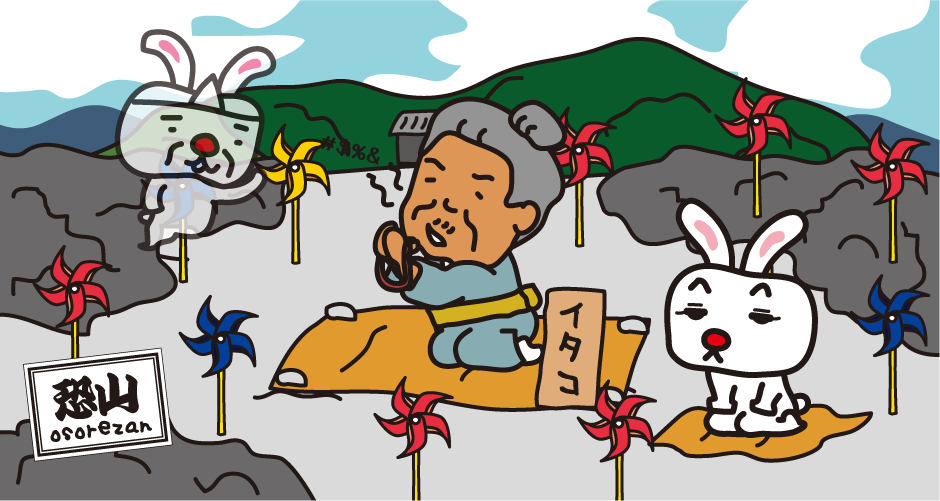Cape Tappi
The strength of the wind at Cape Tappi was truly astonishing! It was windy and cold, and even in the summer it felt like a “Tsugaru Strait Winter Scenery”!
Cape Tappii is a cape that protrudes into the Tsugaru Strait, the northernmost tip of the Tsugaru Peninsula, and is located in Sotogahama Town, Aomori Prefecture. Surrounded by the sea on three sides, the cape is famous for its strong winds all year round. There are several seascape points in Cape Tappi, but the most popular one is the Tappizaki Lighthouse. You can enjoy the magnificent ocean view of the Tsugaru Strait from the observatory with the lighthouse, and on a clear day you can also see the Matsumae Peninsula in Hokkaido. It is about 19 km to Cape Shirakami in Hokkaido on the opposite shore, and the Seikan Tunnel runs through the seabed.
Song Monument of “Tsugaru Strait Winter Scenery”

Cape Tappi is the site of “Tsugaru Strait Winter Scenery” sung by Sayuri Ishikawa, and there is a stone monument in the shape of a stormy sea. When you press the button on the song monument, the song “Tsugaru Strait Winter Scenery” will be played at a loud volume.
“Tsugaru Straits Winter Scenery” is an enka song that was released in 1977 and became a big hit. The song depicts a winter scene of a woman who gets off the snowy Aomori Station on a night train from Tokyo and boardes the Seikan ferry bound for Hokkaido, looking out over the Tsugaru Strait. By the way, there is a song monument of “Tsugaru Strait Winter Scenery” near the Seikan ferry memorial ship “Hakkoda Maru” in Aomori Port.
Seikan Tunnel Museum “Seikan Tunnel Tappi Shako Line Mogura”

At the Seikan Tunnel Museum, you can learn about the Seikan Tunnel, the world’s largest undersea tunnel that connects Hokkaido and Honshu. We recommend the “Experience Tunnel” where you can experience the world 140m below the sea level by boarding the “Seikan Tunnel Tappi Shako Line Mogura”.
Japan’s only pedestrian-only national road “Stairway National Road”

The approximately 388m section connecting steep cliffs from the area near the Tappizaki lighthouse to the area near the coastal Tappi fishing port is designated as National Route 339, but cars and motorcycles cannot pass through it. It is called “Stairway National Road” and is the only pedestrian road in Japan with 362 steps.

The road was designated as a national highway with plans to improve the road, but the 70-meter difference in elevation and the dense number of houses prevented any improvement of the stairway, eventually, the existence of the “Stairway National Highway” became famous, and it was decided that it would be better to turn it into a tourist attraction, which it is today.
Ryokan inn where Osamu Dazai stayed (currently Cape Tappi Tourist Information Center)

In 1944, Osamu Dazai traveled to the Tsugaru region to write his novel “Tsugaru.” The former Okuya Ryokan inn, where Osamu Dazai stayed, is now used as the Cape Ryupi Tourist Information Center (Tappi-kan). You can see the room where Osamu Dazai stayed.
The huge rock “Mayaishi” related to Minamoto-no-Yoshitsune’s “Northbound Legend“

At Cape Tappi, it is said that when Minamoto-no-Yoshitsune, who had escaped from Hiraizumi (Iwate Prefecture), prayed to Kannon Bodhisattva in front of the raging sea, three Ryome (a horse like dragon with wings) appeared and crossed over to Hokkaido. Minamoto-no Yoshitsune’s “Hokugyo Densetsu (Northbound Legend)” has been handed down, and there is a huge rock called “Mayaishi” Rock related to that legend. The place name “Minmaya” is derived from this “Hokugyo Densetsu (Northbound Legend)”. “Hokugyo Densetsu (Northbound Legend)” is that Minamoto-no-Yoshitsune, who should have committed suicide, actually secretly escaped from Hiraizumi and lived in Hachinohe (Aomori prefecture) for about ten years, and the Fujiwara clan, who had been hiding Yoshitsune, was destroyed by the Kamakura shogunate. It is a folktale passed down in the Hokkaido/Tohoku region that he traveled north from Cape Tatsupi to Hokkaido, where he was worshiped as a god of the Ainu, moved to Sakhalin and Mongolia, and became Genghis Khan.
Access to Cape Tappi
Approximately 3 hours 20 minutes by Shinkansen from JR Tokyo Station to JR Shin-Aomori Station. Approximately 5 minutes from JR Shin-Aomori Station to JR Aomori Station. Transfer to the Tsugaru Line at JR Aomori Station, then take the train to JR Kanida Station for about 40 minutes. Take a replacement bus from JR Kanida Station to JR Minmaya Station for about 1 hour (due to suspension of service between Kanida Station and Minmaya Station on the JR Tsugaru Line). Take a town bus from JR Minmaya Station to Cape Tappi for about 30 minutes.














You need to login to comment on an article.